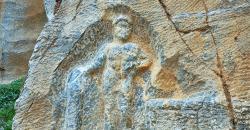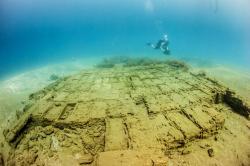INSTITUT SUPERIEUR D'ANTHROPOLOGIE
INSTITUTE OF ANTHROPOLOGY
ONLINE COURSES / COURS A DISTANCE
WINTER TERM : JANUARY 2016
REGISTER NOW
FRANCE –  Amboise - Une importante campagne de fouilles archéologiques s'achève en cette fin de semaine, à Amboise : c'était la première fois que les équipes pouvaient étudier une si grande surface d'un seul coup – 2.000 m² –, ouverte sur l'oppidum des Châtelliers, qui n'est rien de moins que la plus grande agglomération gauloise du territoire des Turons. es archéologues ont notamment trouvé une sépulture en pleine terre, dont le squelette est bien conservé. Ce personnage aurait été inhumé entre la fin de la période gauloise et le tout début de notre ère. C'est une découverte inattendue, qui pose de nombreuses questions sur le statut de ce personnage : « Pourquoi cette sépulture a-t-elle été placée là, à l'intérieur de la ville ? » On ne connaît pas encore la localisation de la nécropole gauloise. « Ce n'est pas une sépulture d'abandon, car cette personne a été enterrée avec soin », ajoute l'archéologue. Le défunt porte un bracelet en bronze à son poignet gauche, et un poignard, dans son fourreau, avait été déposé à sa droite. L'autre découverte majeure a été faite au fond de l'un des puits de ce quartier gaulois et gallo-romain : il s'agit d'une statuette gauloise en tuffeau jaune local. C'est sans doute un dépôt rituel, puisque l'objet était entouré de pièces animales. D'environ 40 cm, cette statuette représente un personnage assis en tailleur, un peu comme un Bouddha.« Elle était posée face contre terre, elle est donc très bien conservée, et complète », souligne Jean-Marie Laruaz. C'est une découverte d'importance nationale, car « c'est le premier exemplaire complet découvert dans son contexte archéologique, de ce très rare groupe de représentation », souligne Jean-Marie Laruaz. Ces statuettes « d'assis en tailleur », dont il existe une trentaine d'exemplaires en France, sont essentiellement gallo-romaines. Mais celle qui a été trouvée à Amboise est clairement gauloise, et c'est une production locale. Cet émouvant petit personnage replet et nu porte un collier massif, un torque, qui est un « attribut aristocratique ou guerrier », précise l'archéologue, « ce qui lui confère une symbolique très forte de pouvoir ». La statuette en tient un autre dans la main, et là, « c'est une connotation divine ». Elle est en cours de restauration.
Amboise - Une importante campagne de fouilles archéologiques s'achève en cette fin de semaine, à Amboise : c'était la première fois que les équipes pouvaient étudier une si grande surface d'un seul coup – 2.000 m² –, ouverte sur l'oppidum des Châtelliers, qui n'est rien de moins que la plus grande agglomération gauloise du territoire des Turons. es archéologues ont notamment trouvé une sépulture en pleine terre, dont le squelette est bien conservé. Ce personnage aurait été inhumé entre la fin de la période gauloise et le tout début de notre ère. C'est une découverte inattendue, qui pose de nombreuses questions sur le statut de ce personnage : « Pourquoi cette sépulture a-t-elle été placée là, à l'intérieur de la ville ? » On ne connaît pas encore la localisation de la nécropole gauloise. « Ce n'est pas une sépulture d'abandon, car cette personne a été enterrée avec soin », ajoute l'archéologue. Le défunt porte un bracelet en bronze à son poignet gauche, et un poignard, dans son fourreau, avait été déposé à sa droite. L'autre découverte majeure a été faite au fond de l'un des puits de ce quartier gaulois et gallo-romain : il s'agit d'une statuette gauloise en tuffeau jaune local. C'est sans doute un dépôt rituel, puisque l'objet était entouré de pièces animales. D'environ 40 cm, cette statuette représente un personnage assis en tailleur, un peu comme un Bouddha.« Elle était posée face contre terre, elle est donc très bien conservée, et complète », souligne Jean-Marie Laruaz. C'est une découverte d'importance nationale, car « c'est le premier exemplaire complet découvert dans son contexte archéologique, de ce très rare groupe de représentation », souligne Jean-Marie Laruaz. Ces statuettes « d'assis en tailleur », dont il existe une trentaine d'exemplaires en France, sont essentiellement gallo-romaines. Mais celle qui a été trouvée à Amboise est clairement gauloise, et c'est une production locale. Cet émouvant petit personnage replet et nu porte un collier massif, un torque, qui est un « attribut aristocratique ou guerrier », précise l'archéologue, « ce qui lui confère une symbolique très forte de pouvoir ». La statuette en tient un autre dans la main, et là, « c'est une connotation divine ». Elle est en cours de restauration.
TURQUIE –  Iznik - The right arm of a Heracles relief in an ancient quarry in the northwestern province of Bursa’s İznik district has suffered damage due to the agricultural industry in the area, according to cultural specialists. The area of the human-size Heracles relief, which is carved into a rock in the Deliklitaş area, eight kilometers from İznik, was declared a protected area by the Council of Monuments in 1990. The left arm of the relief was already broken when the object was discovered. Now, however, salty and chemical waste from olive processing in the area are also damaging the relief. Taylan Sevil, who worked as a museum director in İznik for 12 years, said the natural rock area of the Heracles relief had served as a quarry in ancient times and that the stones used on the city walls around İznik were brought from there. He said the area was taken under protection in 1990 after the relief was found. “The relief is believed to have been made to protect quarry workers. In the relief, Heracles has his crook in his right hand and a seven-headed snake in his left hand. It is one of the artifacts that should be taken under protection,” he said.
Iznik - The right arm of a Heracles relief in an ancient quarry in the northwestern province of Bursa’s İznik district has suffered damage due to the agricultural industry in the area, according to cultural specialists. The area of the human-size Heracles relief, which is carved into a rock in the Deliklitaş area, eight kilometers from İznik, was declared a protected area by the Council of Monuments in 1990. The left arm of the relief was already broken when the object was discovered. Now, however, salty and chemical waste from olive processing in the area are also damaging the relief. Taylan Sevil, who worked as a museum director in İznik for 12 years, said the natural rock area of the Heracles relief had served as a quarry in ancient times and that the stones used on the city walls around İznik were brought from there. He said the area was taken under protection in 1990 after the relief was found. “The relief is believed to have been made to protect quarry workers. In the relief, Heracles has his crook in his right hand and a seven-headed snake in his left hand. It is one of the artifacts that should be taken under protection,” he said.
http://www.hurriyetdailynews.com/Default.aspx?pageID=238&nid=92506&NewsCatID=375
PANAMA -  Las Perlas - L'Unesco a exprimé samedi son inquiétude sur la dégradation du site archéologique de l'épave du San José au Panama. L'exploitation commerciale de l'épave du San José, galion espagnol naufragé dans les eaux panaméennes au 17e siècle, ne répond pas aux critères d'une démarche scientifique et a causé d'importants dommages à ce site archéologique. Telle est la conclusion d'un rapport de l'Unesco suite à la mission d'experts effectuée dans l'archipel de Las Perlas. "La méthode de relevé archéologique ... n'est pas conforme aux protocoles actuels en matière de pratique archéologique professionnelle", notent les experts dans leurs conclusions, tout en précisant que l'exploitation de l'épave a été particulièrement dommageable pour le site archéologique. Ainsi, l'utilisation de déflecteurs à hélices, qui génèrent de puissants jets d'eau ayant pour effet de déplacer les sédiments et creuser le sol, a été préjudiciable à une documentation précise du site. Ces méthodes sont contraires aux règles internationalement reconnues contenues dans l'Annexe de la Convention de l'Unesco, ratifiée par le Panama. Les experts condamnent l'approche purement mercantile du projet, qui s'est focalisé sur la seule recherche de biens présentant une valeur commerciale. Le San José, un vaisseau espagnol construit en 1611, avait quitté le port de Callao, au Pérou, pour se rendre au Panama. Il a coulé 17 juin 1631 après avoir heurté le fond, emportant avec lui une importante cargaison d'or et d'argent.
Las Perlas - L'Unesco a exprimé samedi son inquiétude sur la dégradation du site archéologique de l'épave du San José au Panama. L'exploitation commerciale de l'épave du San José, galion espagnol naufragé dans les eaux panaméennes au 17e siècle, ne répond pas aux critères d'une démarche scientifique et a causé d'importants dommages à ce site archéologique. Telle est la conclusion d'un rapport de l'Unesco suite à la mission d'experts effectuée dans l'archipel de Las Perlas. "La méthode de relevé archéologique ... n'est pas conforme aux protocoles actuels en matière de pratique archéologique professionnelle", notent les experts dans leurs conclusions, tout en précisant que l'exploitation de l'épave a été particulièrement dommageable pour le site archéologique. Ainsi, l'utilisation de déflecteurs à hélices, qui génèrent de puissants jets d'eau ayant pour effet de déplacer les sédiments et creuser le sol, a été préjudiciable à une documentation précise du site. Ces méthodes sont contraires aux règles internationalement reconnues contenues dans l'Annexe de la Convention de l'Unesco, ratifiée par le Panama. Les experts condamnent l'approche purement mercantile du projet, qui s'est focalisé sur la seule recherche de biens présentant une valeur commerciale. Le San José, un vaisseau espagnol construit en 1611, avait quitté le port de Callao, au Pérou, pour se rendre au Panama. Il a coulé 17 juin 1631 après avoir heurté le fond, emportant avec lui une importante cargaison d'or et d'argent.
http://french.xinhuanet.com/2015-12/13/c_134910445.htm
CHINE – Guyuan - A rare well-preserved marble sphinx carving has been unearthed in a tomb in northwest China dating back more than 1,000 years, said Chinese archeologists on Tuesday. The delicately-carved sphinx statue is 36 cm high with 21 cm long and 13 cm wide base. It has a human face with a bulge on the head and a sitting lion body. The sphinx statue was excavated in November along with eight warrior, horse, camel and lion carvings in the tomb in Guyuan City, Ningxi Hui Autonomous Region. The tomb was one of the 29 ancient graves in the area which archeologists have excavated this year to pave way for the construction of a local water plant. More than 150 funeral items, such as carvings, pottery, bronze and iron wares, have been unearthed from the graves so far. The sphinx statue, made of white marble according to preliminary research, was intact except for minor damage in the middle of the face. These nine marble carvings showed excellent craftsmanship, said Fan Jun, head of the excavation team of the Ningxia Cultural Relics and Archaeology Institute. According to an epitaph, the tomb housed Liu Jun and his wife, who lived during the Tang Dynasty (618-907). "The style carvings had features from the west and are considered rare for ancient Chinese tombs during that period," said Fan. The white marble material was also rarely seen in north China, he added. The excavations will help scientists better understand freight transport during the Tang Dynasty, said Fan. Ningxia was along the ancient Silk Road trade route.
http://news.xinhuanet.com/english/2015-12/15/c_134919096.htm?